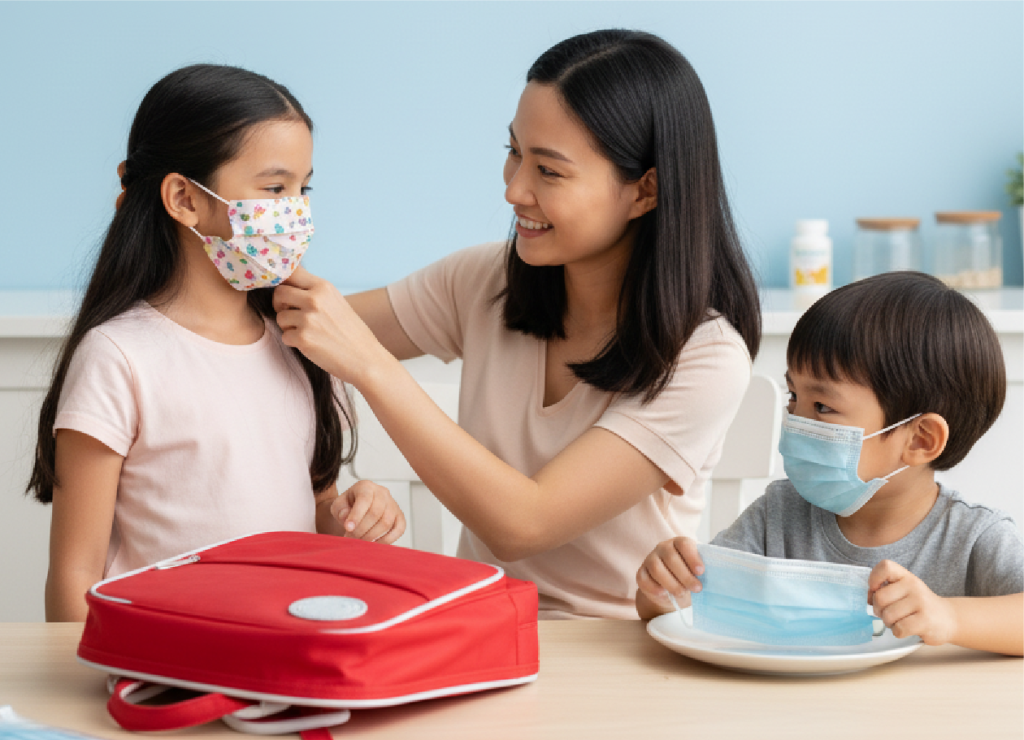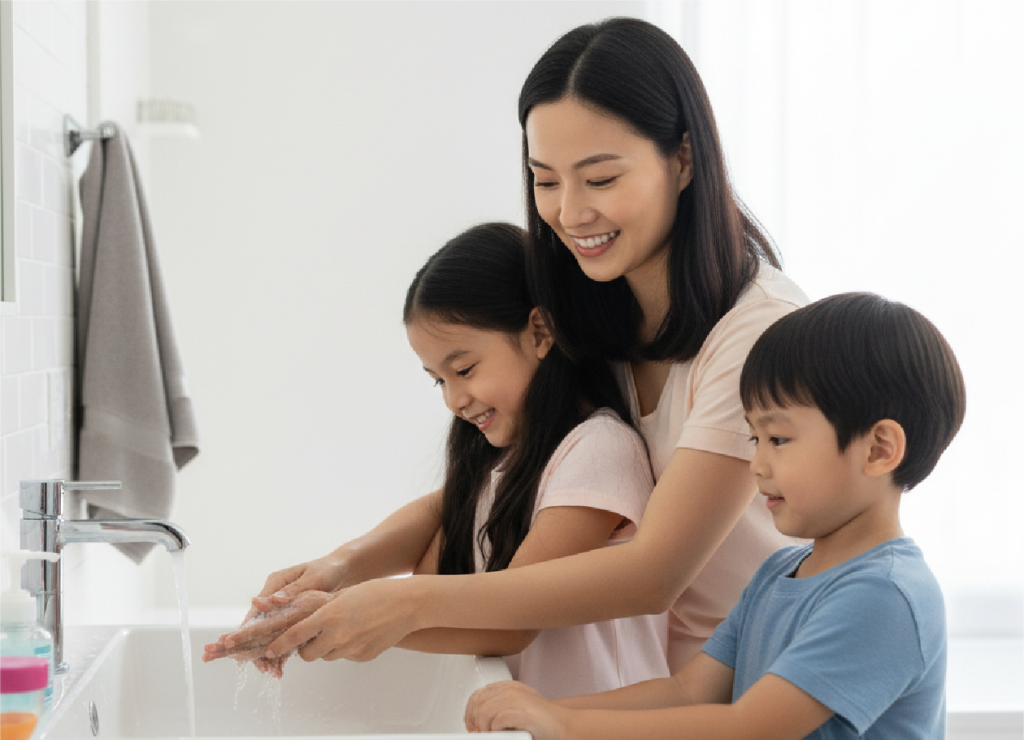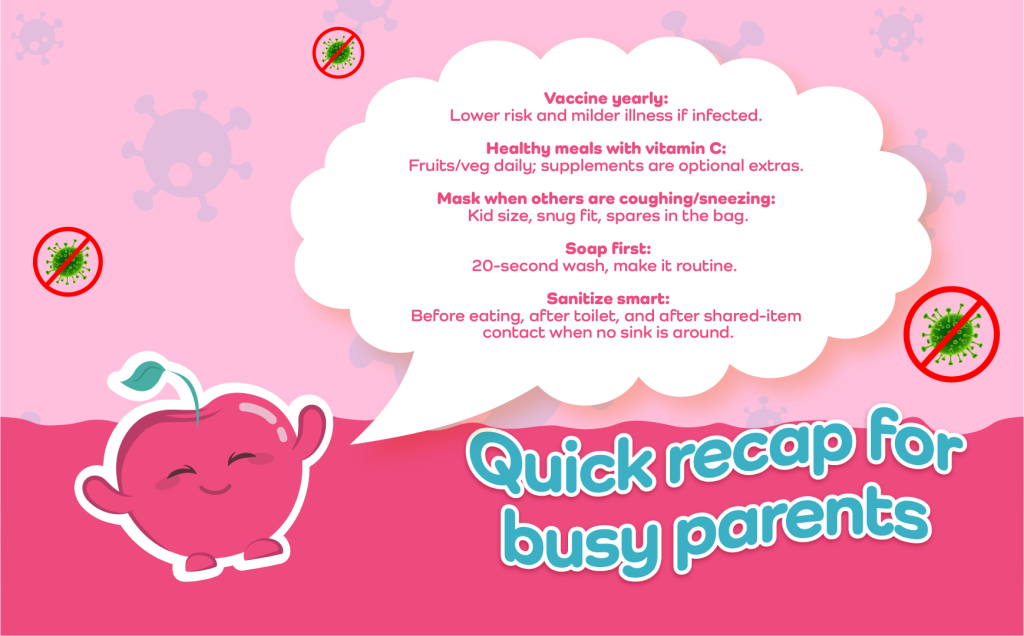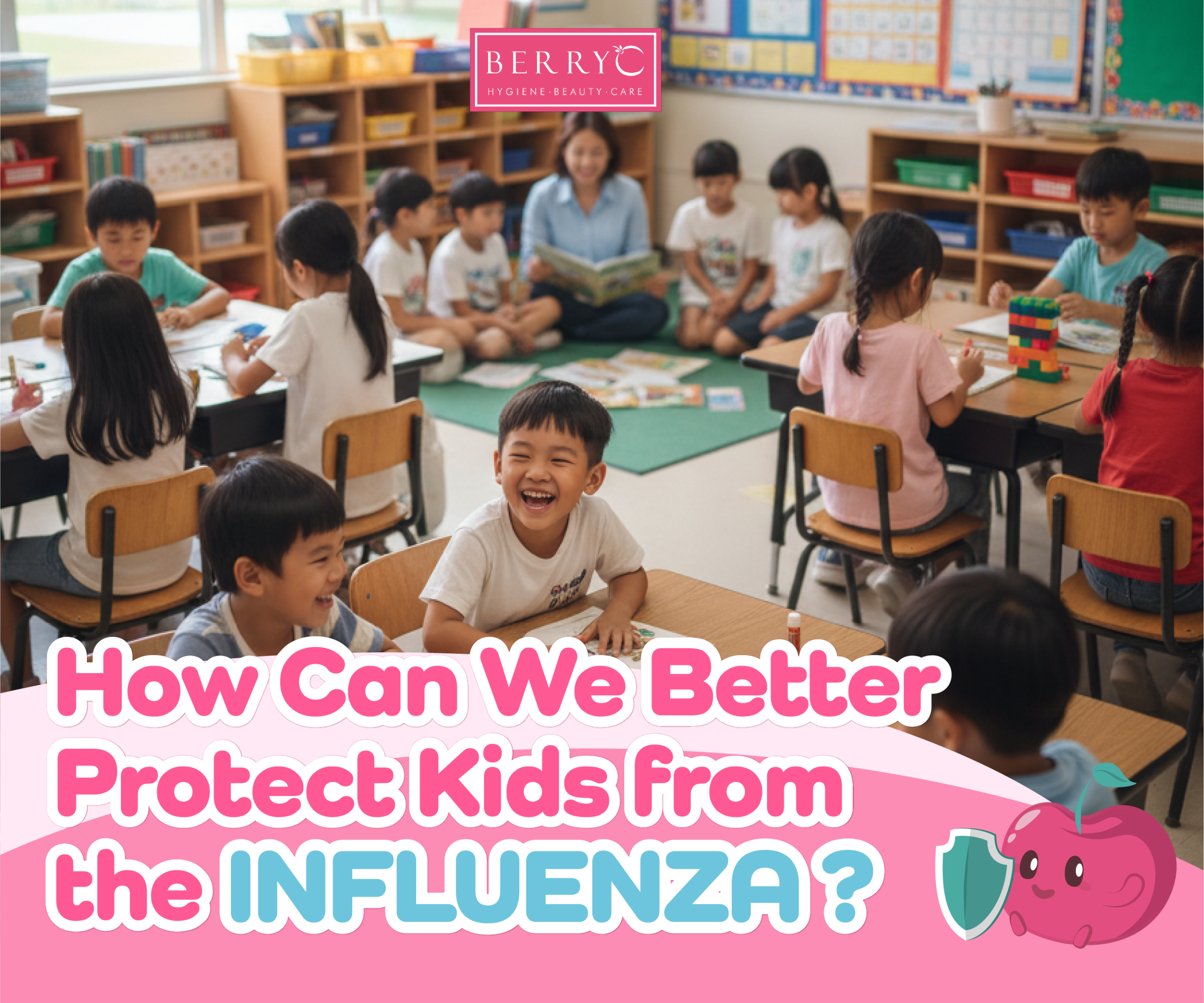Influenza spreads fast in places where children learn, play, and share—classrooms, daycare, and after-school activities. While we can’t eliminate the risk completely, we can stack the odds in our favour with a few practical habits that are easy to teach and repeat. Below is a parent-friendly game plan: simple actions that cut the chances of infection and, if kids do fall sick, help reduce the severity and keep families, classmates, and teachers safer.

1) Get a yearly vaccine
Why it matters
- The flu virus changes from year to year. The vaccine is updated annually to match the strains most likely to circulate.
- Vaccination lowers the risk of getting flu. If infection still happens, it typically reduces the severity—shorter illness, fewer complications, and lower chance of hospitalisation.
- Kids who are vaccinated also help protect others (newborns, grandparents, immunocompromised classmates) by reducing spread.
Who and when
- Eligible age: Children from 6 months and above.
- First-timers (6 months–8 years): Usually 2 doses in the first season, 4 weeks apart; then 1 dose yearly.
- Timing tip: Don’t wait for a surge. Book early so your child is protected before peak season.
Parent pointers
- If your child has asthma, heart conditions, diabetes, or other chronic issues, vaccination is especially important.
- Keep a reminder in your calendar for next year’s shot; make it a back-to-school routine.

2) Serve a healthy plate with enough vitamin C
Big picture
- Food first. A balanced diet provides vitamin C plus other nutrients that support the body’s immune response.
- Supplements are a bonus, not a replacement for real food. Use age-appropriate products and follow the label or your clinician’s advice.
Kid-friendly vitamin C foods
- Fruits: Oranges, tangerines, guava, kiwi, strawberries, papaya, mango.
- Veggies: Broccoli, bell peppers, tomatoes, spinach, kailan/sawi.
- Snack ideas:
- Orange wedges + yogurt
- Papaya cubes with a squeeze of lime
- Rainbow veggie sticks with hummus
- Mini tomato and cheese skewers
- Smoothie: banana + mango + handful of spinach
Simple habits that help
- Offer fruit or veg at every meal—even a few slices count.
- Keep washed fruit within reach for after-school bites.
- Let kids pick a “colour of the day” (red strawberries, green kiwi) to make variety fun.
About supplements (quick note)
- Choose child-formulated drops/chewables if you use them.
- More isn’t better—large doses can upset tummies.
- If your child has kidney issues, G6PD deficiency, or iron-overload conditions, speak to your clinician before supplementing.

3) Wear a mask when classmates are sneezing or coughing
Fit is everything
- Kids need kid-sized masks. Adult masks won’t seal properly and defeat the purpose.
- Check for a snug fit over nose, cheeks, and chin with minimal gaps. Adjust the nose wire.
- Teach kids to handle masks by the ear loops, not the front.
When to use
- During class if a nearby child is coughing/sneezing.
- On crowded buses or indoor assemblies.
- When your child has mild symptoms and needs to attend necessary appointments (follow school policy).
Care & comfort
- Pack spare masks in a labelled pouch.
- Change if the mask becomes wet or soiled.
- Choose breathable materials your child tolerates; practice at home so it feels normal.

4) Wash hands regularly with soap
Why soap wins
- Soap lifts germs and breaks down the grime they hide in. Rinsing with water alone isn’t enough.
Make it a habit
- At least 20 seconds. A good trick: sing “Happy Birthday” twice.
- Key moments: before eating, after toilet, after blowing nose, after recess, after touching shared toys, and when arriving home.
Kid-proof technique
- Wet hands → soap → rub palms, backs of hands, between fingers, thumbs, and under nails → rinse → dry thoroughly.
- Put a step stool near the sink and keep liquid soap easy to pump.
- Use visual stickers or a sand timer to make it fun.

5) Use hand sanitizer at the right moments
When to use sanitizer
- If there’s no sink available: before eating, after toilet, after a classmate coughs onto shared items, or after your child handles their own belongings that others touched.
How to use it well
- Choose a quick-dry product and teach kids to use a proper dollop (enough to cover hands fully).
- Rub all over—palms, backs, between fingers, around thumbs—until completely dry.
- Remind kids: Don’t lick hands after sanitizing; wait until it dries. Supervising teachers or parents should guide younger children.
- School bag checklist
- Travel-size sanitizer with a secure cap.
- A small tissue pack.
- Spare kid-size masks in a clean pouch.
- A snack box and water bottle labelled with your child’s name to reduce mix-ups.



Conclusion
Protecting kids from the flu isn’t about one “magic” step—it’s about layering simple habits that work together. A yearly vaccine builds the first wall of defence; everyday nutrition, well-fitted masks during sniffly seasons, clean hands with soap, and smart sanitizer use reinforce it. With a little planning and consistent routines at home and school, we can keep classrooms healthier, reduce absences, and help our children learn and play with confidence all year long.





